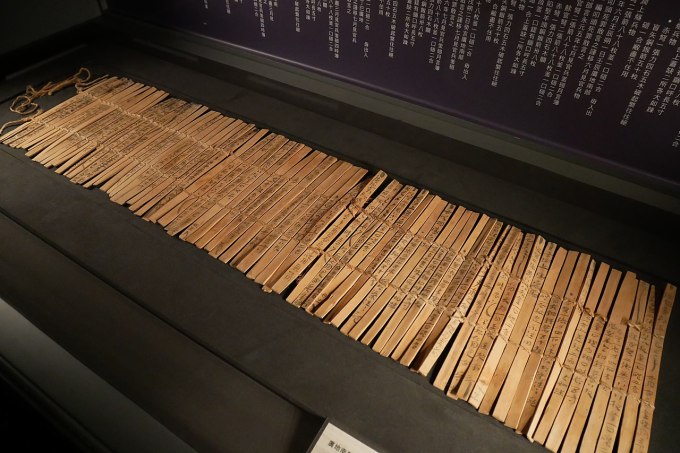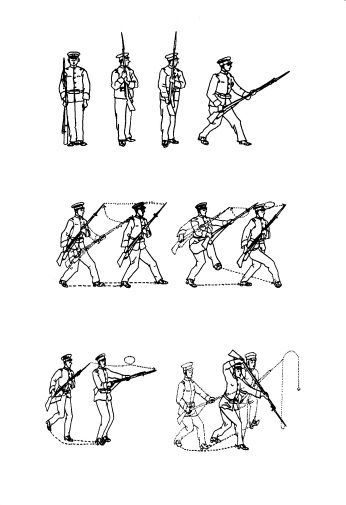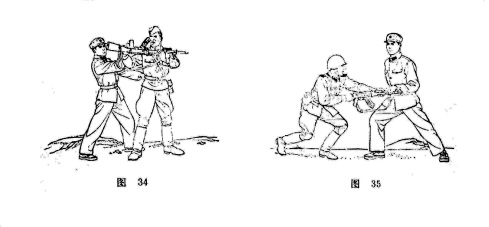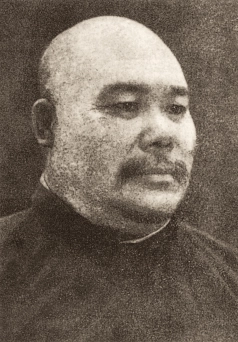This is my first post after getting rid of my Blogger account several months ago, I am hoping to write an entry at least once a month on topics that I hope can trigger curiosity towards a better understanding of Chinese Martial Arts. As a disclaimer English is not my first language, therefore sentence structure can read “funny” at times so please be patient. However, I hope the main message will still be understood. I encourage the readers to contribute to the discussion as I welcome constructive criticism.
I came across a video in Youtube posted in 2009, titled The San Da – Sambo Controversy. The author is David Ross. The video in question argues that Sanda (a Chinese form of kick boxing that includes take downs) was influenced by Russian Sambo in the 1920s. We will attempt to refute this claim looking at the information available to date.
Ross’ argument as it appears in the above mentioned video is as follows:
 David Ross’ Sanda-Sambo manual
David Ross’ Sanda-Sambo manual
” This is related to a discussion of whether Chinese martial art is the SOLE influence on San Da. I contend that NO, there are many non Chinese influences. I believe there is a strong SAMBO influence. So here are scans from old San Da manuals. They show guys in Sambo outfits, i.e. LONG SLEEVES, SHORTS and WRESTLING BOOTS. They also show sacrifice throws. So where did this come from?
San da was begun as a military project in China in 1925 with the help of SOVIET advisors. Those Soviet advisors already had active Sambo programs in the Soviet Union because sambo dates back to the Russo-Japanese war”.
Note: Capitals are Ross’ not mine
EDIT: The video in question has since the publication of this post been taken down (1/20/2021).
The Origins of Russian Sambo
Early Sambo was the brain child of Vasili Oschepkov and Victor Spiridonov sometime in the early 1920s or 1930s [1] [2] when the government started to look at creating a method to teach the Russian military armed and un armed fighting techniques. Sambo is an eclectic system as it was based on different folk wrestling styles, Greco-Roman wrestling, Savate, English Boxing, Chinese Martial Arts (I have not seeing concrete evidence of this in the literature), Karate, Judo and Ju Jutsu [3]. It is important to point out that Jigoro Kano’s Judo is a synthesis of different Ju Jutsu styles, among them the Kyto Ryu school. The Japanese credit the creation of Kyto Ryu to a Chinese expatriate named Chen Yuan [4] as found in a Tokio shrine. It appears that the Russian interest in hand to hand combat was a result of the superior fighting skills demonstrated by the Japanese during the Russo – Japanese war in the period 1904-1905; the Japanese were quiet proficient at bayonet fighting, demonstrated in 1904 at a friendly competition against Royal Marines in Seoul (Joe Svinth mentions Shanghai in his article), the western forces more adept to the use of rifle-bayonet fighting at that time [5]. French Savate was practiced in Russia before 1917 and some elements of that art might have been incorporated in Sambo as it developed. By the 1930s the art was codified and formally recognized in the Soviet Union in 1938 [18].
Sino – Russian cooperation at the Whampoa Military Academy (Zhongguo Guomindang Lujun Junguan Xuexiao, 中國國民黨陸軍軍官學校) in Guangzhou province was mainly to provide political agitation, military thought and history [6] lectures to the Chinese students led by Russian officer Vasily Blyukher between 1924 – 1927 [7]. Vasily was also responsible for the planning of the Northern Expedition that took place from 1926 to 1927, rather than hand to hand combat. In fact, it was during Vasily’s time in China that the Russians were beginning to develop Sambo. Moreover, it would make more sense that the Chinese sought to learn the victorious Japanese’s methods rather than those of the defeated Russians, which makes the Sambo connection hard to support based on the above information.
Sanda vs. Sanshou
It is important to understand the difference between the two terms if we want to placed them correctly in the history and development of what is now known as Sanda. In essence both Sanda and Sanshou are used to describe fighting. Let’s start with Sanshou (translated as scatter hands, 散手), it is a term much older than Sanda (Free Striking, 散打). It first appeared in Han Dynasty bamboo slips (居廷漢簡), where the following sentence was found, “Xiang Cuo Xu, Xiang San Shou/相錯畜, 相散手” (To raise [animals] on one another, To Scatter Hands on one another) [8]; this phrase depicts some type of fighting event or competition.

The term Sanshou was also used during the Chinese Republican period and appeared in books and articles of the time, as an example Xu Longhou’s “Luohan Training Methods” (Luohan Xing Gong Fa, 1924) preface reads.” Trainers of Chinese boxing (quanshu) have two fundamental methods. The first is Sanshou with the purpose of proficiency in practical application (yingyong). The second one is physical training methods to strengthen a person’s health”.
“拳術基本教練之法有二。一曰散手” [19]
In the Methods of Applying Taiji Boxing (太极拳使用法) by Yang Chengfu ( 杨澄甫) published in 1931. In Yang’s books there is a description related to the usage of Taijiquan in free practice as follows: “When facing an opponent, be it either pushing hands or sparring…“ (Yu Ren Duidi,Ru Tuishou Huo San Shou/ 与人对敌,如推手或散手) [9].
In traditional Chinese Martial Arts it is common to refer to Free Practice/Sparring using the term Sanshou. Sanda on the other hand seems to have been used in some novels published during the Republican period [8], hence Ross’ use of the Sanda term for the republican period is an oversight.
Yang Chengfu
Martial arts practice by the military at the time were based on traditional methods, examples are teaching Xing Yi Quan (Mind and Intent Boxing, , 形意拳) for hand to hand combat both with and without weapons to the officers of the Military Academy at Nanjing [10] and possibly during the time the academy was in Guangzhou. The book Teaching Mind and Intent Boxing ( Xing Yi Quan Xie Jiao Fan/ 形意拳械教範 ) by Huang Bo Nian (黃柏年) and Jiang Rong Qiao (江容樵) is the first traditional Chinese martial arts manual to be used for military training. The manual contains the five elements patterns to be applied for empty hand, rifle-bayonet and western saber fighting [10]. Lian Bu Quan (Continuous Steps Boxing, 連步拳) was taught to Chinese commandos and women’s militias during WWII at Changsha and Baoding [11]. Muslim (Hui) brothers Ma Yingtu (馬英圖) and Ma Fengtu (馬鳳圖) experts in Ba Ji Quan (八極拳), Chuo Jiao (戳腳), Pi Gua Quan ( 劈掛拳), Fanzi Quan (翻子拳) organized a training curriculum for the Northwest Army; including the creation of a Da Dao Dui (Big Knife Team) unit for warlord Feng Yuxian (nicknamed the Christian General) as well as active members in the Central National Arts Academy programs (Zhongyang Guoshu Guan, 中央國術館) [12].
All of the above examples were in alignment with the goals of the government of the time, that sought to support the traditional cultural elements that were unique to the Chinese nation [13]. To infer that the Chinese did not have native skills to draw from is at best inaccurate. Most of the influence regarding sparring gear, the study of fighting techniques with saber and bayonet in order to neutralize the ones used by the enemy by the Nationalists came from the comparison with Japanese methods, not Russian.
 Xing Yi Quan bayonet techniques from Huang Bonian’s book, author’s personal collection
Xing Yi Quan bayonet techniques from Huang Bonian’s book, author’s personal collection
After the Communist takeover of the mainland, several changes were implemented, competitions including traditional practices like martial arts were abolished after the Sports Games, Convention , Exhibition and National Ethnic Competition (Quanguo Minzu Xingshi Tiyu Biaoyan Ji Jingsai Dahui, 全國民族形式體育表演及競賽大會) that took place in 1953 in the city of Tianjin [14]. Free fighting events were also abolished after 1949 [8], western boxing was banned in 1959 [15]. These changes, also affected military martial arts; rather than using traditional systems like during the Republican period the Communist started to develop their own methods maybe as early as the 1950s – 1960s with the creation of a series of short routines named Capture the Enemy [for intelligence Purposes] (Bu Fu Quan) published as short booklets. These routines included empty hand, dagger and bayonet. The previous routines were combined into a longer set that appeared in a chart called Capture the Enemy Diagram (Qindi Di Quan Tu Xie). Later a set of manuals published by the 1970s included one with armed and unarmed techniques against Russian soldiers. By 1976 a new set of routines were created called Military Fist (Junti Quan) currently taught to some units of the Chinese army and college students, the Military Police (Wu Jin) has a different set of routines for empty hand, baton and dagger.
 Chinese military martial arts manual, 1974. Note the enemy is a Russian soldier, author’s personal collection
Chinese military martial arts manual, 1974. Note the enemy is a Russian soldier, author’s personal collection
The term Sanda appeared in official documents in 1978 published by the Sports Commission and Physical Culture (Guo Jia Ti Wei, 國家體委) in a three volumes edition, one of which was titled Attacking Skills and Free Striking (San Da Ji Ji Shu) [16]. It is worth mentioning that Sanda or Sanshou as it is promoted by the IWUF (International Wushu Federation, 国际武术联合会, Guoji Wu Shu Lianhehui), is an independent element of Competition Wushu (竞技武术 – Jing Ji Wu Shu) from the practice of routines or (武术套路 – Wu Shu Tao Lu), both Sanda and Sanshou have been used interchangeably in competitions organized by the IWUF. PLA combat manuals in our possession use the term Gedou, 格斗 (to wrestle/struggle) rather than Sanda or Sanshou.
Chinese military martial arts, unlike its sport counterpart do preserve the traditional way of training, that is, start with routines practice, fighting applications from the movements learnt in the routines to free fighting. This approach is completely different from Sambo, where there are no routines practice; even though Chinese martial arts do have grappling, fighting on the ground as in Sambo is avoided and rather the Chinese exponent will fight from the ground looking to return to a standing position.
Final Thoughts
Upon a closer observation of the picture from the manual presented by Ross, one can see that it is written in simplified characters as it became common use with the communists, the manual’s format is to be read from left to right and top to bottom as in western books. However during the republican period the texts were published to be read in columns, from top to bottom and right to left and written in traditional characters. Hence, Ross’ manual might have been published after the Chinese Cultural Revolution (Wuchanjieji Wenhua Dageming, 無產階級文化大革命) that lasted from 1966 to 1976 (I would venture this was published in the 1980s or later), when fighting practices were allowed. The techniques illustrated by Ross are sport oriented and not the ones we have seen in Russian military combat manuals during WWII. Finally, the term Sambo has no equivalent in the Chinese language, if a Chinese writer wishes to promote a book about Sambo, he/she will need to use a popular term that refers to fighting, in this case Sanda or Sanshou as both have been used interchangeably since 1978. In my opinion the connection made by Ross in his video does not hold to scrutiny and that one needs to really look into more than just once source before coming to such conclusion, unless of course the author decides to reveal his source and this mysterious 1920s manual. There is some Russian influence after WWII as some Russian manuals were translated into Chinese towards the end of WW2, yet subsequent Chinese military combat manuals include elements not seeing in Russian Sambo e.g., the practice of routines with and without weapons. To sum up, we can say that it is Sambo that owns its beginnings to Japanese and perhaps to some extend to Chinese Martial Arts among other sources, the final product is without a doubt entirely Russian.
Works Cited
[1] “Wikipedia,” [Online]. Available: http://en.wikipedia.org/wiki/Sambo_(martial_art). [Accessed 19 04 2014].
[2] “Classic Black Belt Article From 1967: Russia Prepares to Export Sambo (Part 1),” Black Belt Magazine, [Online]. Available: http://www.blackbeltmag.com/daily/traditional-martial-arts-training/sambo/classic-black-belt-article-from-1967-russia-prepares-to-export-sambo-part-1/. [Accessed 19 04 2014].
[3] A. Gorbylev. [Online]. Available: http://www.samoz.ru/earticle.php?id=562. [Accessed 19 04 2014].
[4] S. Henning, “Academia Encounters the Chinese Martial Arts,” China Review International , vol. 6, no. 2, pp. 319-332, 1999.
[5] J. R. Svinth, “An Introduction to Training in Rifle-Bayonet Fighting in the US Military,” November 1999. [Online]. Available: http://ejmas.com/jnc/jncart_svinth3_1199.htm. [Accessed 19 04 2014].
[6] “Whampoa Military Academy,” Wikipedia, [Online]. Available: http://en.wikipedia.org/wiki/Whampoa_Military_Academy. [Accessed 19 04 2014].
[7] “Vasily Blyukher,” [Online]. Available: http://en.wikipedia.org/wiki/Vasily_Blyukher. [Accessed 19 04 2014].
[8] L. Ma, “Wuxuepedia,” Journal of Chinese Martial Studies, no. 3, p. 84, 2010.
[9] P. Brennan, “METHODS OF APPLYING TAIJI BOXING (TAIJI QUAN SHIYONG FA),” [Online]. Available: http://brennantranslation.wordpress.com/2011/11/24/methods-of-applying-taiji-boxing-taiji-quan-shiyong-fa/. [Accessed 19 04 2014].
[10] D. Rovere, The xingyi quan of the Chinese army : Huang Bo Nien’s Xingyi fist and weapon instruction, Blue Snake Books, 2008.
[11] D. Rovere and W. Acevedo, “Lian Bu Quan: El Método de los Comandos Chinos,” El Budoka 2.0, no. 6, pp. 16-26, 2011.
[12] W. Acevedo and M. Cheung, “Las Artes Marciales del Ejercito Chino en el Periodo Republicano,” Revista de Artes Marciales Asiaticas, pp. 22-37, 2009.
[13] W. A. &. M. Cheung, “Análisis de las Publicaciones Periodicas Marciales Chinas editadas durante el l Periodo Republicano,” Resvista de Artes Marciales Asiaticas, vol. 6, no. 1, pp. 35 -60, 2011.
[14] M. Mingda, “Reconstructing China’s Indigenous Physical Culture,” Journal of Chinese Martial Studies, vol. Summer, no. 1, pp. 8-31, 2009.
[15] S. Brownell, Trainnig the body for China, University of Chicago Press, 1995.
[16] L. Boyuan, Zhongguo Wu Shu Shi, Taibei: Wu zhou chu ban she, 1985.
[17] K. Gewu, The Spring and Autumn of Chinese Martial Arts, Plum Publishing, 1995.
[18] Tausk, Gene P., Martial Arts of the World Vol. 2, p 513
[19] P. Brennan, “THE LUOHAN EXERCISES”, by Xu Longhou [Yusheng] 1924. https://brennantranslation.wordpress.com/2021/07/31/the-eighteen-luohan-exercises-according-to-xu-yusheng/?fbclid=IwAR0E0GitjHllv-EcbPAHMM4JIfh5Ry8ueUS2PpXhvvPOHZdkQeys-oqqasE


There is a Chinese martial arts manual from the early/mid-1960’s (c. 1966) on the “eight fairies style” (drunken style) of martial arts that shows a practitioner in boots & shorts similar to sambo-sanda manual pictured above. so if that is being used as a basis of proof for a sambo/sanda connection it will need more validation than that. As well, my teacher who taught at whampoa in the late 1920’s and was in the 3rd graduating class, never mentioned Russian sambo as part of their training. I would also add that if you look at Chinese military training manuals (such as “kill with one blow”) you will see the enemy portrayed as American soldiers.
Hello Dennis, Thanks for your comment very interesting to know about the sources you have. Cheers
For an English-language history of sambo, see Gorbylev, Alexey. 2010. “Sambo.” In Green, T.A. and Svinth, J.R., eds. _Martial Arts in the Modern World: An Encyclopedia of History and Innovation_ (Santa Barbara, CA: ABC-CLIO), 2:502-514. Regarding possible influences on Nationalist police and military training, note that the Berkeley Police Department (which was a pioneer in police jujitsu back in the 1920s) and the FBI provided trainers and instructors to the Nationalist police during the 1930s. The Nationalist police also looked to Europe and Japan for training ideas. For an introduction to this, see, for example, Frederic Wakeman’s essay at http://books.google.com/books?id=myNLyqTZCpUC&pg=PA82&lpg=PA82&dq=berkeley+police+department+china&source=bl&ots=pZxVAY_scq&sig=z6NP55a8C1Im009tvh7GJdu_AyI&hl=en&sa=X&ei=51Q5VMpaodeLAvyggGg&ved=0CEAQ6AEwBQ#v=onepage&q=berkeley%20police%20department%20china&f=false . Given that the Zhejiang Academy was tasked with repressing Communism, direct sambo influences would seem unlikely for Nationalist military and police. However, for Communist agents trained during the 1920s or 1930s, Soviet influences are plausible. Personally, though? If I were researching that period, I’m thinking it would be more fruitful to look at the East Asian professional boxing circuit. Lots of White Russians boxed and wrestled professionally in Hong Kong, Shanghai, and Singapore, and professional boxing and wrestling of that period had direct connections to the yakuza and Amur River Society on the one hand and Chinese organized crime groups on the other.
Thanks for the leads and insightful comments Joe, Cheers
To follow up on my previous comment above. Part of Ross’s original argument was based on the fact the Russians sent a contingent of advisors to Whampoa/Huangpu. Thus Russian sambo was taught at Whampoa (with no other corroborating evidence). What he fails to know (or ignores) is the fact the KMT sent a contingent of Chinese advisors to Russia as an exchange at the same time.